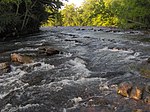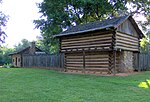Milligan University
1866 establishments in TennesseeAppalachian Athletic Conference schoolsBuildings and structures in Carter County, TennesseeCommons category link is locally definedCouncil for Christian Colleges and Universities ... and 8 more
Education in Carter County, TennesseeElizabethton, TennesseeJohnson City, TennesseeMilligan UniversityPrivate universities and colleges in TennesseeUniversities and colleges accredited by the Southern Association of Colleges and SchoolsUniversities and colleges affiliated with the Christian churches and churches of ChristUniversities and colleges established in 1866

Milligan University is a private Christian university in Milligan College, Tennessee. Founded in 1866 as the Buffalo Male and Female Institute, and known as Milligan College from 1881 to May 2020, the school has a student population of more than 1,300 students, most of whom reside and study on its 355-acre (1.44 km2) campus. Milligan University is historically related to the Restoration Movement. The university offers over 100 programs of study leading to both undergraduate and graduate degrees.
Excerpt from the Wikipedia article Milligan University (License: CC BY-SA 3.0, Authors, Images).Milligan University
Blowers Boulevard,
Geographical coordinates (GPS) Address Website Nearby Places Show on map
Geographical coordinates (GPS)
| Latitude | Longitude |
|---|---|
| N 36.3017 ° | E -82.2951 ° |
Address
Milligan University
Blowers Boulevard 1
37682
Tennessee, United States
Open on Google Maps




